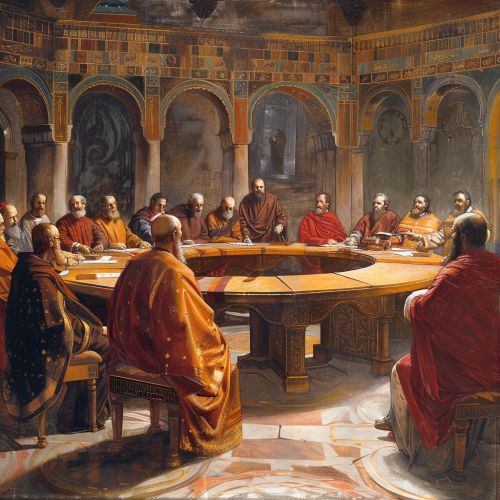Miaphysite: Difference between revisions
(Created page with "== Introduction == Miaphysitism is a Christological doctrine that emerged in the early Christian Church as a response to the theological debates surrounding the nature of Christ. The term 'Miaphysite' is derived from the Greek words 'mia' and 'physis', meaning 'one' and 'nature', respectively. This doctrine asserts that in the person of Jesus Christ, the divine and human natures are united in one or single nature ('physis'), the two being united without separation, witho...") |
No edit summary |
||
| (One intermediate revision by the same user not shown) | |||
| Line 2: | Line 2: | ||
Miaphysitism is a Christological doctrine that emerged in the early Christian Church as a response to the theological debates surrounding the nature of Christ. The term 'Miaphysite' is derived from the Greek words 'mia' and 'physis', meaning 'one' and 'nature', respectively. This doctrine asserts that in the person of Jesus Christ, the divine and human natures are united in one or single nature ('physis'), the two being united without separation, without confusion, and without alteration. This stands in contrast to the [[Chalcedonian Creed|Chalcedonian]] definition, which asserts that Christ has two natures in one person. | Miaphysitism is a Christological doctrine that emerged in the early Christian Church as a response to the theological debates surrounding the nature of Christ. The term 'Miaphysite' is derived from the Greek words 'mia' and 'physis', meaning 'one' and 'nature', respectively. This doctrine asserts that in the person of Jesus Christ, the divine and human natures are united in one or single nature ('physis'), the two being united without separation, without confusion, and without alteration. This stands in contrast to the [[Chalcedonian Creed|Chalcedonian]] definition, which asserts that Christ has two natures in one person. | ||
[[Image:Detail-79143.jpg|thumb|center|A historical depiction of a council discussing Miaphysite doctrine|class=only_on_mobile]] | |||
[[Image:Detail-79144.jpg|thumb|center|A historical depiction of a council discussing Miaphysite doctrine|class=only_on_desktop]] | |||
== Historical Development == | == Historical Development == | ||
Latest revision as of 07:55, 17 May 2024
Introduction
Miaphysitism is a Christological doctrine that emerged in the early Christian Church as a response to the theological debates surrounding the nature of Christ. The term 'Miaphysite' is derived from the Greek words 'mia' and 'physis', meaning 'one' and 'nature', respectively. This doctrine asserts that in the person of Jesus Christ, the divine and human natures are united in one or single nature ('physis'), the two being united without separation, without confusion, and without alteration. This stands in contrast to the Chalcedonian definition, which asserts that Christ has two natures in one person.


Historical Development
The development of Miaphysitism was primarily a reaction against the Council of Chalcedon held in 451 AD, which declared that Christ had two distinct natures, divine and human, in one person. This Chalcedonian definition was rejected by several Eastern Churches, leading to the first major schism in the Christian Church. These non-Chalcedonian Churches, including the Armenian Apostolic Church, the Coptic Orthodox Church of Alexandria, the Ethiopian Orthodox Tewahedo Church, and the Syriac Orthodox Church, are often referred to as 'Miaphysite' Churches.
Theological Basis
The theological basis of Miaphysitism is rooted in the teachings of St. Cyril of Alexandria, who used the phrase 'one incarnate nature of the Word' in his Christological formula. Cyril's teachings were seen as a middle ground between the doctrines of Nestorius, who argued for two separate natures in Christ, and Eutyches, who proposed a monophysite (single nature) view. Cyril's formula was intended to safeguard the belief in Christ's true divinity and true humanity against the Nestorian and Eutychian heresies.
Miaphysite Churches
The Miaphysite Churches, also known as Oriental Orthodox Churches, have maintained their distinct theological perspective throughout history. Despite being separated from the rest of Christianity after the Council of Chalcedon, these Churches have continued to uphold the Miaphysite doctrine, emphasizing the unity of Christ's nature as the Word of God made flesh.
Controversies and Schisms
The Miaphysite doctrine has been a source of controversy and schism within the Christian Church. The Council of Chalcedon's rejection of Miaphysitism led to the first major split in the Church, separating the Eastern Churches that accepted the Council's definition from those that did not. This schism was further entrenched by political and cultural differences between the Greek East and the Latin West.
Modern Perspectives
In modern times, the Miaphysite doctrine is still upheld by the Oriental Orthodox Churches. However, there have been significant efforts towards reconciliation and dialogue with the Eastern Orthodox and Roman Catholic Churches. These discussions have often centered around the understanding of Christ's nature, with many theologians arguing that the differences between the Miaphysite and Chalcedonian positions are more linguistic than substantive.
